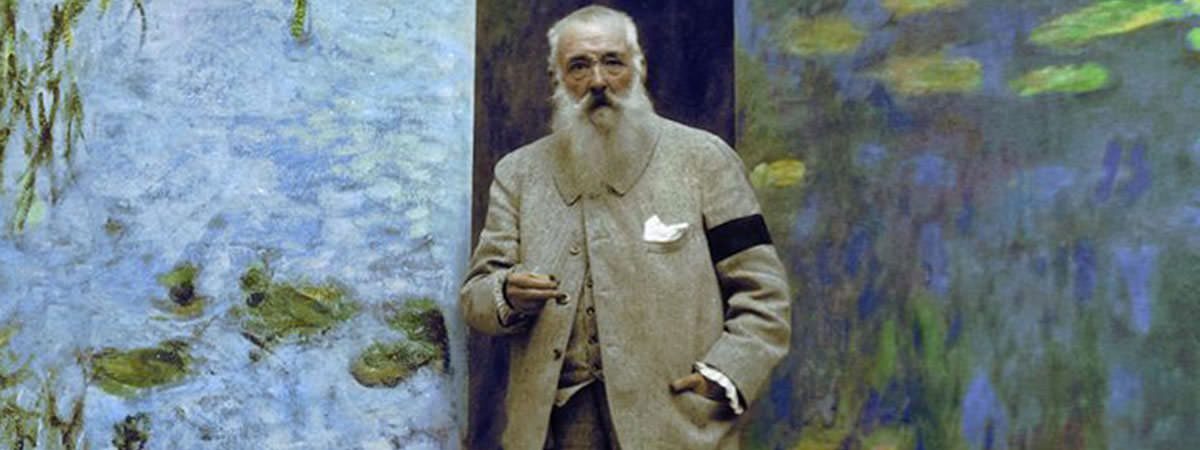Claude Monet was a French artist closely associated with the art movement Impressionism, whose artists aimed to render on canvas their perception of a scene rather than the exact details. Impressionism was one of the most influential movements in art history. Monet was one of its pioneers and its most ardent practitioner due to which he is revered as the “Father Of Impressionism”. Born in a middle-class family, Monet chose art despite his father’s reservations. He initially struggled as an artist to the point that he once attempted suicide. With time, as Impressionism became popular, he was hailed as one of the greatest painters in France. Monet married twice, first to a model named Camille Doncieux and then to Alice Hoschede, after her first husband died. He outlived his second wife as well and he had to also endure the loss of his eldest son Jean. Despite the tragedies in his life, Monet continued to grow as a painter and he produced many of his best known masterpieces in the late stages of his career. Know all about Claude Monet through his biography, interesting facts about him, his most famous works and his best quotes.
BIODATA
| BIRTH | November 14, 1840 – in 45 rue Laffitte, in the 9th arrondissement of Paris, France. |
| EDUCATION | * College du Havre (1851), secondary school of the arts in Le Havre, Normandy * Académie Suisse (1858 – 1860), art school at the Boulevard du Palais, Paris * Beaux-Arts de Paris * Studio of Charles Gleyre (1862), Paris – This is where he met several future Impressionists |
| OCCUPATION | Artist |
| KNOWN FOR | * Being the most famous and prolific painter of the art movement Impressionism. * Creating some of the most famous works of Impressionism including Impression, Sunrise (1872) and the Water Lilies series (1897–1926). |
| FATHER | Claude Adolphe Monet (1800 – 1871) – a grocer and a ship handler by profession. |
| MOTHER | Louise Justine Aubrée (1805 – 1857) – a trained soprano singer. |
| SIBLINGS | * Léon Pascal Monet (1836 – 1917) |
| WIVES | * Camille Doncieux (1847 – 1879) – worked as a model for Claude Monet and other Impressionists before marrying Monet in 1870. * Alice Hoschedé (1844 – 1911) – wife of department store magnate and art collector Ernest Hoschedé. She married Monet in 1892 after her husband’s death. |
| CHILDREN | * Jean (1867 – 1914) – a pharmacist * Michel (1878 – 1966) – served in the French Army during World War I. |
| DEATH | December, 5 1926 (aged 86) – due to lung cancer. |
| PLACE OF DEATH | At his home in Giverny, France |
BIOGRAPHY
Early Life
Born on November 14, 1840 in Paris, Claude Monet was the second son of Claude-Adolphe Monet and his wife Louise-Justine Aubrée Monet. He was baptized on May 20, 1841 as Oscar-Claude though his family members simply called him Oscar. In 1845, the Monet family moved to Le Havre in Normandy, where Oscar was raised. His father wanted him to join the family grocery store business but Oscar was more interested in arts. In 1851, he joined College du Havre, a secondary school of the arts.
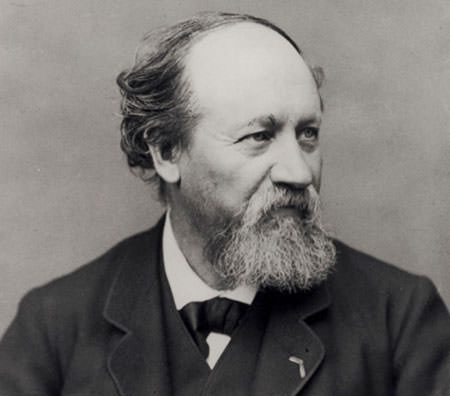
In his teenage, Monet gained a local reputation as a caricaturist. He used to sell them for ten to twenty francs. He received his first instructions in drawing from Jacques-François Ochard, a former student of Jacques-Louis David. Around 1856-57, Monet met Eugène Boudin, who was one of the first French landscape painters to paint outdoors and who painted resorts along region’s Channel coast. It was Boudin who introduced Monet to painting en plein-air (outdoors). Boudin had a great influence in the career of Monet. In fact Monet later said: “If I have become a painter, it is entirely due to Eugène Boudin.”
Education And Early Career
Monet’s mother died on January 28, 1857. At the age of 16, he went to live with his widowed childless aunt, Marie-Jeanne Lecadre. It was she who supported him in his early career as an artist. In June 1861, Monet joined the First Regiment of African Light Cavalry in Algeria for two years of a seven-year commitment. However, he contracted typhoid and his aunt intervened to get him out of the army. In 1862, Monet went to Paris to study painting. He joined the studio of the academic history painter Charles Gleyre. It was here that Monet met Auguste Renoir, Alfred Sisley, Frédéric Bazille and other future Impressionists. These artists shared new approaches and techniques which would later become hallmarks of Impressionism.
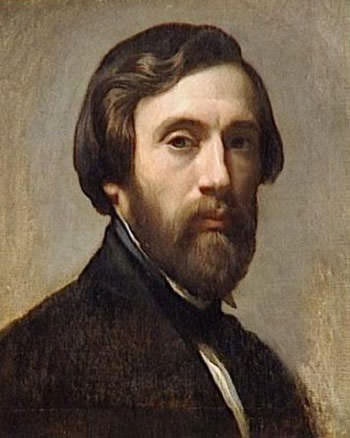
The state sponsored Salon was the best way for an artist to be recognized in France at the time. In his early career, Monet enjoyed moderate success as an artist with several of his paintings being accepted at the Salon. His 1866 portrait, The Woman in the Green Dress, was especially successful and fetched him 800 francs, a great amount for a struggling artist. The model in the painting is Monet’s lover and future wife Camille Doncieux. She had met Monet, seven years her senior, the previous year. In 1867, Camille gave birth to their first son, Jean, out of wedlock.
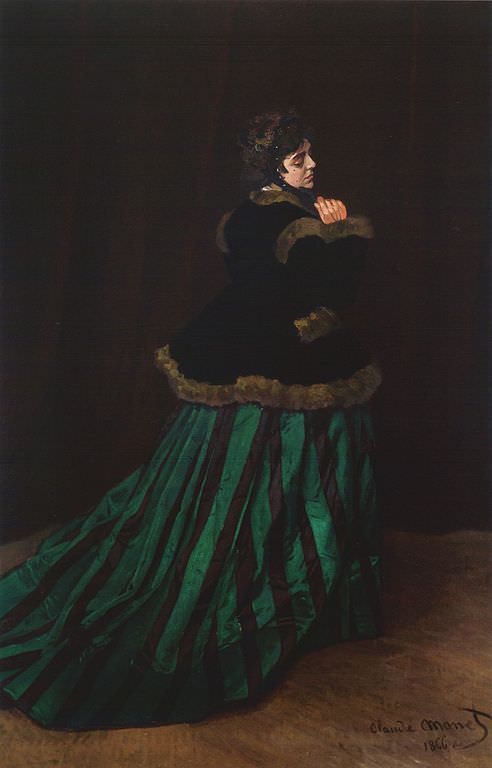
This was a difficult time for Monet as he was struggling as an artist and now he had to raise a family. His main source of income at the time was his wealthy aunt’s support. However, once his child was born, his father made him choose between his family’s wealth and Camille and their child. Monet choose Camille. However, his situation worsened and his new family was evicted from their home. It was at such a time, in 1868, that Monet tried to take his own life by jumping into the Seine River. Luckily for him and the art world, his attempt failed as his swimming skills saved him.
Impressionism
In 1870, during the Franco-Prussian War, Monet fled France to first settle in London and then in Zaandam, Netherlands. In late 1871, he returned to France and settled at Argenteuil, a suburb just west of Paris. By the late 1860s, Monet had largely abandoned figurative painting in favor of created spontaneous works created en plein air. However, his art was repeatedly rejected by the Salon. In 1874, Monet, Renoir, Sisley, Pissaro, Degas, Morisot and others decided to organize an independent exhibition alongside the Salon. The rebelling artists chose the former studio of photographer Nadar to display some 200 works of art. Most of the critics lambasted their works. Monet’s painting Impression, Sunrise was at the heart of one critic’s ridicule as he wrote: “A preliminary drawing for a wallpaper pattern is more finished than this seascape.” The rebels took the criticism in their stride and named their movement Impressionism on Monet’s painting.

Monet and his family stayed in Argenteuil, from December 1871 to 1878. This was the time when he painted some of the best known works of Early Impressionism including Impression, Sunrise. In 1878, Camille Monet gave birth to their second son, Michel. However, this deteriorated her already failing health. She died on September 5, 1879. At this time, the Monet family was living with Alice Hoschedé and her six children, who had been invited their as Alice’s husband Ernest had gone bankrupt. Ernest Hoschede used to be a wealthy department store magnate in Paris. He was also a patron of Monet and his friend. After the death of Ernest Hoschede in 1891, Monet married Alice Hoschede in 1892. The couple remained together till the death of Alice in 1911.
Series Paintings And Death
In 1883, Monet discovered Giverny, a village northwest of Paris that became his home for 43 years. He first rented a house here. By 1890, he had become a successful artist and could buy the house, the surrounding buildings and the land for his gardens. Monet usually worked directly on his canvases outdoors and provided the finishing touches later in his studio. By late 1890s, he started working on “series” paintings. This was an important breakthrough both in Monet’s career and in the history of art. The paintings were meant to be viewed as a series and they captured the same subject again and again bringing out the minute changes in varying light and weather conditions.
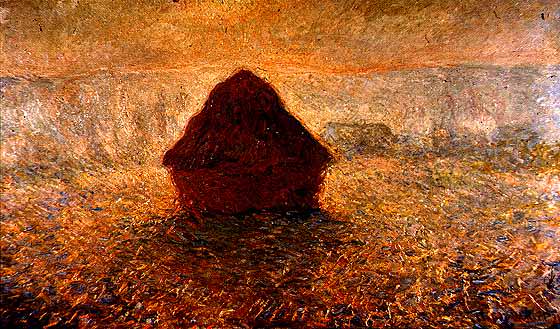
Haystacks was the first series he exhibited in 1891. Other series paintings of Monet include Rouen Cathedral, Poplars, the Houses of Parliament, Mornings on the Seine and the Water Lilies. The last among these is considered his greatest masterpiece. For 30 years, between 1897 and his death in 1926, he produced more than 250 oil paintings in his Water Lilies series. In the early paintings (1897–99), he captures the pond environment with its plants, bridge and trees neatly divided by a fixed horizon. However, with time, he became less concerned with conventional pictorial space and the late paintings of the series combine Impressionism with Expressionism and are on the verge of being abstract.

Monet’s second wife Alice died in 1911 while his son Jean died in 1914. These losses had a devastating effect on Monet. Moreover, he developed cataracts and started to become blind. By 1912, his vision had dropped to 20/50; by 1918, to 20/100; and by 1922, to estimated 20/200, which would make him legally blind. Nonetheless, all this while, Monet continued to paint. His work from the period when the cataracts affected his vision have a general reddish tone. In January 1923, he underwent surgery for one eye with the other being a backup in case something went wrong. The surgery went well and Monet continued to work. On December 5, 1926, Claude Monet died of lung cancer at his home in Giverny. He was 86 years old.
Main Sources:-
“Biography Of Claude Monet”. Claude Monet Gallery.
Auricchio, Laura. (Oct 2004). “Claude Monet (1840–1926)”. The Metropolitan Museum of Art.
(Aug 2, 2012). “The Hidden History Of Claude Monet’s ‘L’Enfant A La Tasse, Portrait De Jean Monet'”. HuffPost Entertainment. BuzzFeed, Inc.
(August 21, 2018). “Claude Monet, Impact on Impressionism”. Telfair Museums.
Solomon, Deborah. (Dec 2, 2016). “The Story of Claude Monet’s Water-Lily Masterworks”. The New York Times Company.
INTERESTING FACTS
#1 Monet Attempted Suicide
#2 He Painted His Wife Camille On Her Deathbed
#3 His Second Wife Destroyed The Photographic Record Of His First Wife
#4 Claude Monet Is Regarded as the “Father Of Impressionism”
#5 Impressionism Is Named After A Painting Of Monet
#6 He Followed A Meticulous Method To Create His Landscapes
#7 His Late Water Lilies Paintings Moved Toward Abstraction
#8 He Was Close Friends With Prime Minister Georges Clemenceau
#9 He May Have Seen The UV Spectrum After His Cataract Operation
#10 His Haystack Painting Is The Most Expensive Impressionist Art To Be Sold At Auction
MOST FAMOUS PAINTINGS
| RANK | TITLE | LOCATION | YEAR |
| #10 | Rouen Cathedral Series | Multiple museums | 1892 – 1894 |
| #9 | Bain à la Grenouillère | The MET, New York City | 1869 |
| #8 | The Magpie | Musée d’Orsay, Paris | 1869 |
| #7 | Wild Poppies Near Argenteuil | Musée d’Orsay, Paris | 1873 |
| #6 | San Giorgio Maggiore at Dusk | National Museum Cardiff, Wales | 1908 |
| #5 | The Artist’s Garden at Giverny | Musée d’Orsay, Paris | 1900 |
| #4 | Woman with a Parasol | National Gallery of Art, Washington, DC | 1875 |
| #3 | Haystacks Series | Multiple museums | 1887 |
| #2 | Impression, Sunrise | Musée Marmottan Monet, Paris | 1872 |
| #1 | Water Lilies Series | Multiple museums | 1897 – 1926 |
TOP QUOTATIONS
“The richness I achieve comes from nature, the source of my inspiration.”
On Nature
“Color is my daylong obsession, joy, and torment.”
On Color
“If I became a painter, it is to Eugène Boudin that I owe that fact.”
On Eugène Boudin
“When you go out to paint, try to forget what objects you have before you, a tree, a house, a field, or whatever. Merely think, here is a little square of blue, here an oblong of pink, here a streak of yellow.”
On Painting In His Style
“More than ever despite my poor sight, I need to paint and paint unceasingly.”
On Cataracts Affecting His Eyesight
“I’m never finished with my paintings; the further I get, the more I seek the impossible and the more powerless I feel.”
On His Work
“Anyone who says he has finished a canvas is terribly arrogant.”
On Finishing A Painting
“I must have flowers, always, and always.”
On Flowers
“Everyone discusses my art and pretends to understand, as if it were necessary to understand, when it is simply necessary to love.”
On Appreciating His Art
“I want to paint the way a bird sings.”
On What He Wants To Paint

